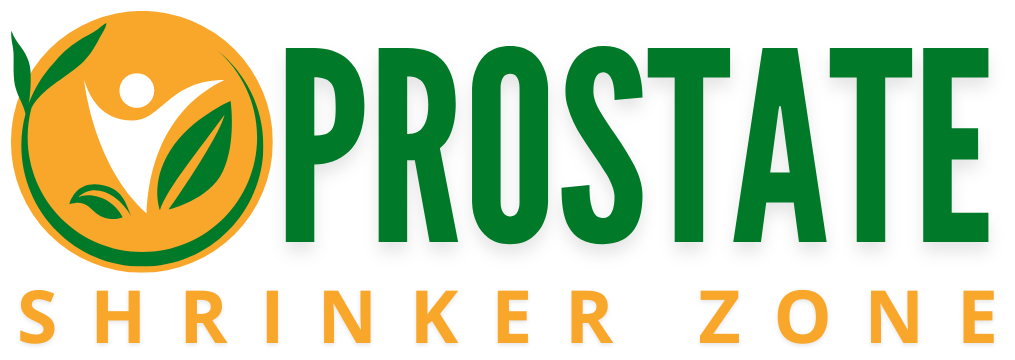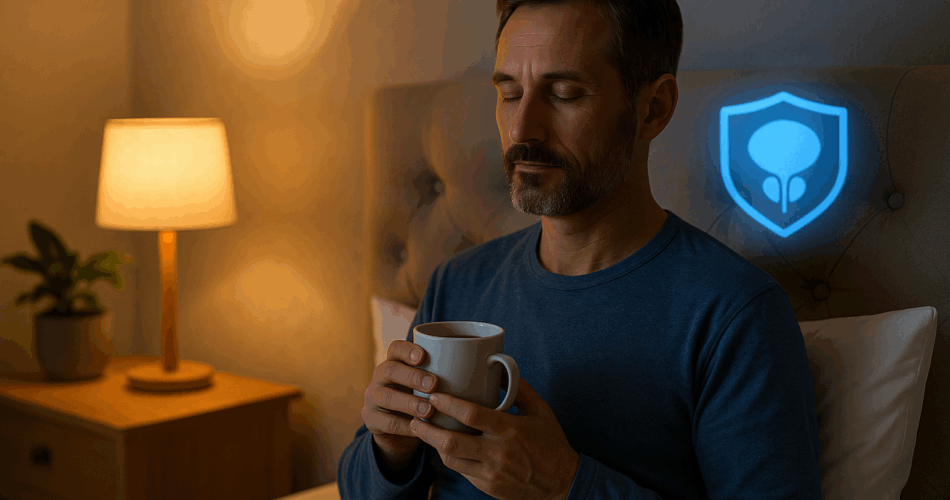An enlarged prostate—often called benign prostatic hyperplasia (BPH)—can make nights frustrating: frequent trips to the bathroom, weak stream, and a sleep cycle that never settles. While no habit “cures” BPH on its own, smart evening routines can reduce urinary urgency, calm the bladder, and improve sleep quality. This Prostate Shrinker Zone guide lays out five practical, low-risk bedtime habits designed to help.
Quick note: These strategies are supportive and educational. They do not replace medical evaluation, especially for severe, sudden, or persistent symptoms.
Understanding BPH (Enlarged Prostate) in Plain Terms
BPH is a non-cancerous growth of prostate tissue that can press on the urethra and irritate the bladder. The result? More urgency, more nighttime urination (nocturia), and disrupted sleep. Hormones, age-related tissue changes, mild inflammation, diet, and nerve sensitivity all play roles.
Goals at night:
- Minimize bladder stimulation
- Reduce inflammation triggers
- Encourage full, relaxed emptying before bed
- Support deeper, longer sleep
How Nighttime Habits Influence Prostate Symptoms
Evening choices can either settle the urinary tract or wind it up. Late heavy meals, salty foods, alcohol, and caffeine can pull fluid into the bladder right when the body should be resting. Tight hips and weak pelvic floor muscles can make bladder control less efficient. Heat and relaxation—done safely—often reduce pelvic tension and perceived urgency.
Habit #1: Smart Fluid Timing (Hydrate Early, Taper at Night)
Why It Helps
Many men hydrate late by accident, then spend the night emptying the bladder. Shifting most fluids earlier and tapering 2–3 hours before bed gives the kidneys time to process fluids before sleep. Less bladder volume at midnight often means fewer trips.
How To Do It Tonight
- Front-load water intake from morning to mid-afternoon.
- Taper after dinner; take only small sips if thirsty.
- Limit bladder irritants after lunch: coffee, energy drinks, alcohol, cola, highly sweetened beverages, and citrusy sodas.
- Pre-bed bathroom routine: Try a relaxed double void—urinate, stand, breathe for 30–60 seconds, then try again gently.
Pros & Cons
- Pros: Simple, free, immediate impact; improves sleep continuity.
- Cons: Requires planning; those on diuretics or with heart/kidney conditions must coordinate with a clinician.
Habit #2: Anti-Inflammatory Evening Plate (Light, Low-Sodium, Plant-Forward)
Why It Helps
Heavy, salty, or spicy late dinners can increase nighttime thirst and fluid shifts. A lighter, earlier dinner that’s lower in sodium and rich in anti-inflammatory foods helps reduce swelling, reflux, and bladder irritation.
How To Do It Tonight
- Timing: Eat the main meal 3–4 hours before bed.
- Structure: ½ plate non-starchy veggies (broccoli, leafy greens), ¼ plate lean protein (fish, tofu, chicken), ¼ plate whole grains (quinoa, brown rice) or legumes—if tolerated.
- Add-ons: A small portion of pumpkin seeds (source of zinc and phytosterols) at dinner; drizzle extra-virgin olive oil; add berries for dessert if desired.
- Reduce: Processed meats, ultra-refined carbs, very spicy dishes, excess onions/garlic if they trigger urgency/reflux, and alcohol close to bedtime.
Pros & Cons
- Pros: May lower systemic inflammation; supports weight control; fewer reflux-related awakenings.
- Cons: Requires meal planning; individual food triggers vary; fiber increases should be gradual.
Habit #3: Pelvic Floor (Kegel) + Hip Mobility Routine Before Bed
Why It Helps
A well-coordinated pelvic floor supports the urethra and bladder. Gentle strengthening plus hip mobility can reduce urgency and improve control. The key is coordination and relaxation, not just clenching.
How To Do It Tonight
5–8 minutes, bedside routine:
- Diaphragmatic Breathing (1–2 min): One hand on belly, inhale through the nose, feel the belly rise; exhale slowly through pursed lips.
- Pelvic Floor “Lift & Let Go” (2–3 min):
- Imagine drawing the perineum up and in (as if stopping gas flow).
- Hold for 3–5 seconds; fully relax for 5–8 seconds.
- Aim for 8–10 quality reps.
- Hip Mobility (2–3 min):
- Figure-4 stretch (30–45 sec each side).
- Hip flexor stretch (30–45 sec each side).
- Gentle cat-cow on hands/knees for 6–8 cycles.
- Finish with a Relaxed Double Void if needed.
Tip: Over-clenching without relaxation can worsen urgency. The “let go” is as important as the “lift.”
Pros & Cons
- Pros: Zero cost, improves awareness and control, better posture and pelvic comfort.
- Cons: Learning curve; incorrect technique may strain; pelvic pain requires clinician-guided therapy.
Habit #4: Warmth Therapy (Sitz Bath or Heating Pad)
Why It Helps
Gentle warmth can relax pelvic floor muscles, improve local circulation, and ease sensations of urgency or pressure. It pairs well with breathing or reading to promote a calm wind-down.
How To Do It Tonight
- Sitz Bath: Warm (not hot) water in a basin or bathtub; 10–15 minutes about an hour before bed.
- Heating Pad: Low/medium setting placed over lower abdomen or perineal area for 10–15 minutes (avoid direct skin contact; follow device instructions).
- Combine with slow nasal breathing and soft lighting.
Pros & Cons
- Pros: Soothing, quick relief for tension; improves sleep readiness.
- Cons: Not for those with reduced sensation, open wounds, or active skin irritation; keep temperatures moderate to prevent burns.
Habit #5: Sleep-Ritual Stack (Wind-Down, Breathing, and Caffeine Cut-Off)
Why It Helps
Quality sleep stabilizes hormone rhythms and reduces overnight urine production. A steady ritual reduces arousal signals, while earlier caffeine cut-off prevents a stimulant from lingering at midnight.
How To Do It Tonight
- Caffeine Cut-Off: No caffeine after 12–2 PM (earlier if sensitive).
- Blue-Light Hygiene: Dim lights and screens 60–90 minutes before bed.
- Breathing Drill: 4-6 breaths/minute for 5 minutes (inhale ~4–5 seconds, exhale ~6–7 seconds).
- Room Setup: Cool (≈18–20°C / 64–68°F), quiet, dark.
- Consistent Schedule: Same sleep and wake times, even on weekends.
- Urge Delay Strategy: If urgency strikes within 20 minutes of lying down, try 1–2 minutes of slow breathing; if still strong, empty once, then return to bed.
Pros & Cons
- Pros: Improves sleep depth; reduces awakenings; supports overall hormone balance.
- Cons: Requires habit consistency; shift work or small children can complicate routine.
Bonus Tweaks: Evening Supplements & Medication Timing (Talk to a Clinician)
Magnesium Glycinate, Pumpkin Seed Oil, Saw Palmetto (Context)
- Magnesium glycinate (low-dose in the evening) may support relaxation and sleep quality.
- Pumpkin seed oil provides phytosterols and essential fatty acids that may support urinary comfort over time.
- Saw palmetto is commonly discussed for urinary symptoms; responses vary and quality matters.
Important: Supplements can interact with medications (e.g., blood thinners). A clinician or pharmacist should guide dose and suitability.
Alpha-Blockers and 5-Alpha-Reductase Inhibitors: Timing Considerations
- Some alpha-blockers (e.g., tamsulosin) may be taken in the evening to reduce dizziness during the day—only as directed by a prescriber.
- 5-ARIs (e.g., finasteride/dutasteride) are long-acting; timing isn’t usually critical, but adherence is.
Always discuss timing changes with the prescriber to avoid side effects like dizziness, blood pressure drops, or interactions.
Red-Flag Symptoms That Need Medical Attention
- Inability to urinate (acute urinary retention)
- Painful urination, fever, or blood in urine
- Unintentional weight loss, bone pain, or systemic symptoms
- Sudden worsening of urinary flow or new severe nighttime symptoms
One-Week Bedtime Action Plan (Printable)
Day 1–2 (Foundation):
- Move most fluids earlier; taper 3 hours before bed.
- Light dinner by 7–7:30 PM (adjust locally).
- One 10-minute warmth session + double void.
Day 3–4 (Muscle & Mobility):
- Add pelvic floor routine (8–10 controlled reps with full relaxation).
- Hip stretches nightly; 5 total minutes.
- Maintain caffeine cut-off at 12–2 PM.
Day 5–6 (Sleep Deepeners):
- 5–10 minutes of slow breathing before lights out.
- Strict bedroom conditions: cool, dark, quiet.
- Keep wake time consistent.
Day 7 (Review & Adjust):
- Track awakenings/urination count.
- Identify triggers (late fluids, salty meals, alcohol).
- Decide which habit delivered the biggest win and lock it in.
Common Mistakes to Avoid
- Over-restricting fluids all day (can worsen dehydration, constipation, and bladder irritation).
- Doing only “hard” Kegels without relaxation phases.
- Using high heat for too long during warmth therapy.
- Spicy/salty late dinners → thirst and night waking.
- Assuming supplements are harmless without checking interactions.
Pros & Cons Summary (All Five Habits)
- Pros
- Non-invasive and low cost
- Target both bladder irritation and pelvic tension
- Improve sleep quality and next-day energy
- Compatible with clinician-guided treatment plans
- Encourage overall cardiometabolic health (diet, sleep, stress)
- Cons
- Require consistency and tracking
- Benefits are incremental, not instant “cures”
- Some individuals need medication or procedures despite lifestyle changes
- Warmth therapy and Kegels must be done safely and correctly
- Dietary triggers vary; personalization takes time
Final Takeaway: Build a Calm-Body, Calm-Bladder Night
Nighttime relief for an enlarged prostate isn’t a single trick—it’s a stack. Tapering fluids, eating a lighter anti-inflammatory dinner, practicing a short pelvic floor and hip routine, applying safe warmth, and locking in a dependable sleep ritual work together. With steady practice—and medical input where needed—many men report fewer bathroom trips, deeper sleep, and better days.
FAQs
1) Do these habits replace medication for BPH?
No. They are supportive strategies. Some men still need medications or procedures. A clinician can advise on the best mix.
2) How soon can nighttime bathroom trips improve?
Some people notice changes within a few nights (from fluid timing and dinner changes). Pelvic floor training may take 2–6 weeks for noticeable control improvements.
3) Are Kegels safe for everyone?
Most healthy adults can do gentle pelvic floor work. However, pelvic pain, prostatitis, or prior pelvic surgery warrants a pelvic health specialist for tailored guidance.
4) Which drinks are most likely to trigger urgency at night?
Caffeinated beverages, alcohol, carbonated sodas, very sweet drinks, and acidic citrus beverages are common triggers—especially late in the day.
5) Is a sitz bath better than a heating pad?
Both can help. A sitz bath offers uniform warmth; a heating pad is convenient. Use moderate heat, follow safety instructions, and avoid if there is reduced sensation or skin issues.




